
Tiruchirappalli
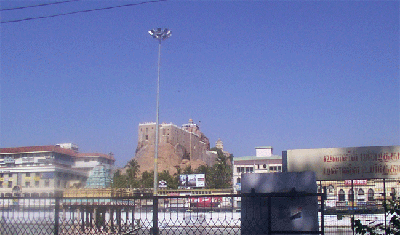 The city of Tiruchirappalli is more popularly known as Trichy. What brings to our mind at the first instance when we talk about Trichy is Malikkottai. This beautiful hill can be seen from all around the city. When we see this hill from far away, it is astonishing to see the images of Lord Shiva’s vahana, Rishabham, Ambal’s vahana Lion, and Lord Ganesha in a sitting posture with His extended trunk. This hill is known as Kailasa of South, devotees offer their prayers to Lord Shiva on the hill itself here. The city acquiring the name of Tiru-chira-palli rests on the presence of Lord Shiva here.
The city of Tiruchirappalli is more popularly known as Trichy. What brings to our mind at the first instance when we talk about Trichy is Malikkottai. This beautiful hill can be seen from all around the city. When we see this hill from far away, it is astonishing to see the images of Lord Shiva’s vahana, Rishabham, Ambal’s vahana Lion, and Lord Ganesha in a sitting posture with His extended trunk. This hill is known as Kailasa of South, devotees offer their prayers to Lord Shiva on the hill itself here. The city acquiring the name of Tiru-chira-palli rests on the presence of Lord Shiva here.
During the 16th century, a Shaivite saint by the name of Ellappanavalar wrote a book called 'Sevvanthi Puranam.' This was a work on the story of Tiruchiramalai. What we understand from this Purana is that a Shiva devotee by the name Tiruchiran performed pooja for the Lord by offering Sevvanthi flowers, hence the presiding deity is known as Sevvanthinathar. Since Tiruchiran prayed the Lord here the city came to be known as Tiruchirappalli.
There is a natural formation of a cave in this hill and it has beds made of stones for Jain saints. Inscriptions of the names of these saints were made on these stones which are of the fifth-century script can be seen even today. One such inscription is on a saint by the name’Chiraa‘. Hence the archeologists and historians believe that this city should have derived its name as Chirappalli.
Tiruchiramalai
The Tiruchirappalli hill has three temples. On the peak is the Uchi Pillayar Temple. In between, there is a rock-cut temple named 'Lalithangura Pallava Ishwara Griham', which was taken by Mahendra Pallavan after he renounced Jainism and converted to Saivism. Beneath this is Thayumanaswamy Temple. The presiding deity of this temple is known by different names – Sevvanthi Nathar, Thirumalai Kozhunthar, Thayumanavar, Thirumalai Perumal Adigal, and Mathrubootheswarar. These are not just conventional names of the places but have significance based on certain reasons.
Today this temple is known more popularly as Thayumanavar Temple. The Sevvanthi Puranam elucidates the blessings that one can get from this Lord in Tiruchiramalai:
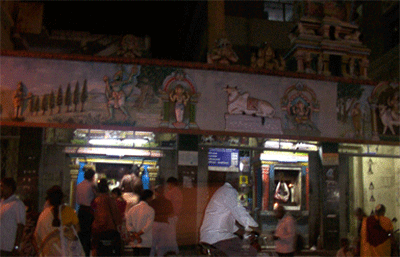 ஒருதலம் இறந்தவர்க்கு உறுதி நல்கிடும்
ஒருதலம் இறந்தவர்க்கு உறுதி நல்கிடும்
ஒருதலம் பிறந்தவர்க்கு உதவும் நல்கதி
இருதலம் தம்மினும் எய்தும் யாவையும்
தருதலம் இது அலால் தரையில் இல்லையே
orudhalam iRndhavarghghu uRudhi nalghiḍhum
orudhalam bhiRndhavarghghu udhavum nalghadhi
irudhalam dhamminum eydhum yāvaiyum
dharudhalam idhu alāl dharaiyil illaiyē
[Kashi will provide Mukthi to those who visit this place. Thiruvarur will provide Mukthi to those who are born in this place. Tiruchiramalai will provide what both these places can give.]
Thayumanaswami Temple
This temple is situated in the mid-height of Tiruchiramalai. One has to take 260 steps to reach this temple. Around the sanctum of Thayumanavar, there is a Prakaram (the outer ring meant for circumambulation) at a much lower level thus the sanctum for Lord Shiva is arranged in two tiers. Further this Prakaram has the idols of Brahma, Agasthyar, Indra, Jatayu, Maharishi Athri, Dhoomakethu, Tiruchiran, Arjuna, Rama, Anjaneya, Vibhishana, Naga Kanni, Saarama Munivar, Rathnavathi, Mounaguru Swamigal, Thayumanava Adigalar, and Sekkazhiyar in one row. The Purana says that all these deities received the blessings of Sevvanthi Nathar. The archeologists believe these idols should have been sculpted during the period of Nayakars.
Normally the deity faces the eastern direction and this is so in this temple as well. Saarma Munivar had once kept some Sevvanthi flowers for performing pooja for the presiding deity and it so happened the Chola king reigning during that period desired to have those flowers. Angered by this act of the king, it is believed Lord Shiva turned towards the West. However, today one can see the entrance to the sanctum and the Kodi Maram (Flag Staff) in the East. Even today while the pooja is performed for the deity, the drums and kettle are played and the Devaram is sung on the Eastern side only.
There is a Nandi Temple on the eastern side of the hill to confirm that the deity was facing East earlier. Today, the Nandi Temple itself is a stand-alone temple, where the deity of Nandi faces West in the direction where the main deity is presenting Himself in a blissful posture at the top of the hill. Before discussing the Nandi Temple, it would be interesting to trace the connection between Tiruchira and the Ramayana.
Further, it is said that Hanuman, who was standing as magnificent as a hill, was offering his prayers and obeisance to the Lord. When the Lord asked Hanuman what he wanted as a boon from Him, Hanuman responded by saying that it was His desire that His symbolic seal of identity should find its place in this holy place.
Tiruchira and Ramayana
Vibhishana, who had come to attend the coronation of Lord Rama, had the good fortune of obtaining the deity of Lord Ranganatha whom Sri Rama propitiated. Vibhishana, while returning to Lanka was supposed to take the deity without placing it down or keeping it on the ground. During the return journey, since Vibhishana had to offer his evening prayers, he chose a small island located between River Cauvery and Kollidam for this purpose. Therefore he had requested a small boy nearby to hold the deity of Lord Ranganatha for some time without keeping it down. However driven by divine destiny, the young boy kept the deity on the ground and that is the place, where the current Lord Ranganathaswamy Temple is located. The young boy is none other than Lord Ganesha and it is He, who is gracing us as Uchi Pillayar in Tiruchiramalai.
Tiruchiran, as described in Sevvanthi Puranam is a devotee of Lord Shiva. He used to worship the Lord on this hill with Sevvanthi flowers. Ravana had sent Khara, Dushan, and Trishira to safeguard the area north of Lanka. Of these three, Tiruchiran only worshipped Lord Shiva with Sevvanthi flowers and hence, the deity here is called Sevvanthi Nathar. This story is narrated in Sevvanthi Puranam. On the behest of the order of Surpanakha, the sister of Ravana, Tiruchiran engages in a battle with Lord Rama and gets vanquished by Him. This piece of information can be found in Ramayana.
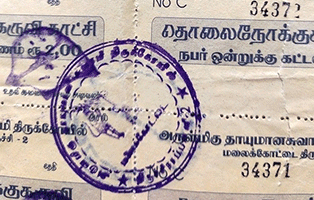 manu ghulandhanil iravi bhuṅghavan
manu ghulandhanil iravi bhuṅghavan
madhalai dhandharuḻ dhayaradhan
manuchan aṅghavan anuchan enbhavar
dhamadhu vembhaghai dhaviravē
ghnal ilaṅghaiyil iḍhum avan
chori gharuṇai añjhanai bhālaghan
anuman enbhavan malaiyil vandhuadhil
ariya nanbhunl āḍhinān
[Anjaneya son of kind-hearted Anjana Devi, had burnt Lanka the kingdom of Ravana who was the enemy of sons of Dasaratha, Rama, and Lakshmana of Surya vamsa.]
Further, it is said that Hanuman, who was standing as magnificent as a hill, was offering his prayers and obeisance to the Lord. when the Lord asked Hanuman what he wanted as a boon from Him, Hanuman responded by saying that it was His desire that His symbolic seal of identity should find its place in this holy place.
This information is given in the Sevvanthi Puranam as ‘Bestowed as Requested’ chapter (நினத்தது கொடுத்த சருக்கத்தில்). Based on this and as already mentioned the deities of Rama, Vibhishana, and Anjaneya have been consecrated here in this temple. Based on this, even today, one can see the divine picture of Lord Anjaneya as a seal in the ‘Receipts’ issued by the temple.
Nandi Temple
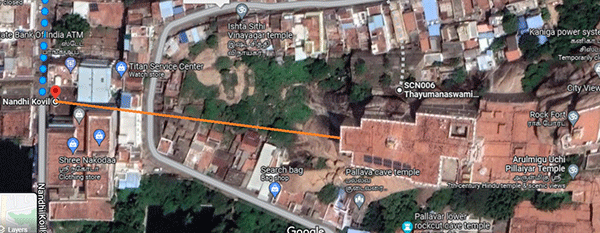 In the foothills on the eastern side of the Thayumanavar Temple, a Temple Tank can be seen. Viswantha Nayakar was the royal representative of the Vijayanagar Kingdom, which was ruled by the Madurai Nayakars at that time. Viswanatha Nayakar built the Tiruchiramalai Fort and the Temple tank. On the western side of this Temple Tank is the Nandi Temple.
In the foothills on the eastern side of the Thayumanavar Temple, a Temple Tank can be seen. Viswantha Nayakar was the royal representative of the Vijayanagar Kingdom, which was ruled by the Madurai Nayakars at that time. Viswanatha Nayakar built the Tiruchiramalai Fort and the Temple tank. On the western side of this Temple Tank is the Nandi Temple.
The Nandi was called so because of His extraordinary physical valour and immense knowledge. Probably because of this reason, Ravanan also thought of Anjaneya as a Nandi! The Group of Nandis are called as Nandi Gana. Being superior amongst Ganas, the Adhikara Nandi has bestowed the responsibility of safeguarding Mount Kailasa, where Lord Shiva resides. Due to this empowerment [Adhikara], he is called Adhikara Nandi Devar.
Since Tiruchiramalai itself is cherished as Kailasa of South, Nandi has been consecrated facing eastward the Tiruchiramali. It is also appropriate that the Nandi is facing Thayumanuvur Temple atop the hill. Since he is located as protector of Kailasa of South he is known as Adhikara Nandi Devar. He stands magnificently tall with a height of 7 feet, 10 feet in length, and 16 feet in diameter like a huge Nandi. Behind the Nandi is a 35-foot-tall Kodi Maram (Flag Staff). There is a Nandi on top of this Kodi Maram also. Following the pooja to Nandi, pooja is also performed to the Kodi Maram. Beneath the Kodi Maram, is the sanctum of Sevvnathi Vinayakar and Veera Anjaneyar facing west.
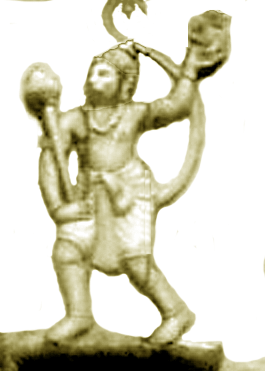 If one looks at these sanctums from Nandi Koil Street, the entrance gate to the Nandi Temple is seen, followed by Sevvanthi Vinayakar Sanctum and Anjaneyar Sanctum. On closer scrutiny of the sculptural characteristics of the Anjaneyar deity, one can conclude that it should have been carved during the Nayaks period.
If one looks at these sanctums from Nandi Koil Street, the entrance gate to the Nandi Temple is seen, followed by Sevvanthi Vinayakar Sanctum and Anjaneyar Sanctum. On closer scrutiny of the sculptural characteristics of the Anjaneyar deity, one can conclude that it should have been carved during the Nayaks period.
Shri Anjaneyar
The idol of Anjaneya is around 3 feet high. Facing North, the deity has His right foot kept in the front. He is seen wearing anklets on both the legs. He is wearing a dhoti in the Kachha style up to his knees. The upper garment is tied around His dhoti. Both His wrists have bracelets, the upper arm is adorned with ‘keyuram’. The mace held by His right hand is resting on His right thigh. The raised left hand is holding the Sanjeevi Hills. His tail is seen raised upwards with a curve and at its tip is a beautiful bell. The sacred thread and the pearl necklace add more beauty to his wide barren chest. And his ears are adorned by Kundalas. His brilliant eyes reflect grace and blessings in plenty.
Location of the temple: "Nandhi temple,Tirucharapalli, TN"
Experience
Ravana understood that Shri Anjaneya was the epitome of strength, valour, knowledge, and intelligence. Despite that understanding, he did not uphold Dharma. Let us adhere to Dharma and receive His blessings and knowledge. Let us be the recipients of Mukthi which is sanctioned by the Lord of Tiruchiramalai.
SRI HANUMAN THINKS DIFFERENTLY, THINKS FAST
THINKS AHEAD AND ACTS FOR SURE
Ed [May 2023]
Updates: [Jan 2025]
